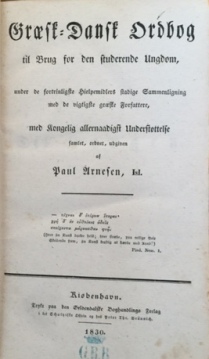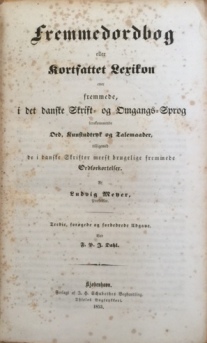Kierkegaard Resources
 The “Resources” page on this website is getting better and better. It now includes links not only to the most recent edition of Kierkegaard’s collected works in Danish and the crucially important Ferrall-Repp Danish-English Dictionary from 1845, but also links to the venerable Ordbog Over Det Danske Sprog (the Danish equivalent of the Oxford English Dictionary), Christian Molbech’s Dansk Ordsprog, a lexicon of Danish saying from Kierkegaard’s time and earlier, Peter Erasmus Müller’s Dansk Synonymik, a Danish thesaurus from 1853, Christian Molbech’s Dansk Ordbog, the definitive Danish-Danish dictionary from Kierkegaard’s lifetime, B.C. Grønberg’s Tydsk-Dansk og Dansk-Tydsk Haandorbog, the more comprehensive of the two German-Danish and Danish-German dictionaries Kierkegaard owned, J.C. Lindberg’s Hebraisk-Dansk Haand Lexicon, the Hebrew-Danish dictionary Kierkegaard owned, and Paul Arnesen’s Ny Latinsk Ordbog, the Latin-Danish dictionary that Kierkegaard owned.
The “Resources” page on this website is getting better and better. It now includes links not only to the most recent edition of Kierkegaard’s collected works in Danish and the crucially important Ferrall-Repp Danish-English Dictionary from 1845, but also links to the venerable Ordbog Over Det Danske Sprog (the Danish equivalent of the Oxford English Dictionary), Christian Molbech’s Dansk Ordsprog, a lexicon of Danish saying from Kierkegaard’s time and earlier, Peter Erasmus Müller’s Dansk Synonymik, a Danish thesaurus from 1853, Christian Molbech’s Dansk Ordbog, the definitive Danish-Danish dictionary from Kierkegaard’s lifetime, B.C. Grønberg’s Tydsk-Dansk og Dansk-Tydsk Haandorbog, the more comprehensive of the two German-Danish and Danish-German dictionaries Kierkegaard owned, J.C. Lindberg’s Hebraisk-Dansk Haand Lexicon, the Hebrew-Danish dictionary Kierkegaard owned, and Paul Arnesen’s Ny Latinsk Ordbog, the Latin-Danish dictionary that Kierkegaard owned.
 There are two conspicuous absences, however, among these resources, because they appear not to be available yet online. The first is Ludvig Meter’s Fremmedordbog from 1853. This is a dictionary of foreign words that had come into Danish by the mid-nineteenth century. This is an absolutely indispensable resource for Kierkegaard scholars because Kierkegaard frequently uses such words and they are generally not found in Molbech. Fortunately, Ferrall-Repp lists many such words in a supplement at the back. Still, the Ferrall-Repp supplement is less comprehensive than Meyer’s and the definitions are very short. The good news is that Meyer’s is still easily available from many Danish antiquarians at reasonable prices. If you click on the image of Meyer to the left, it will take you to the page of an antiquarian where you can purchase the book.
There are two conspicuous absences, however, among these resources, because they appear not to be available yet online. The first is Ludvig Meter’s Fremmedordbog from 1853. This is a dictionary of foreign words that had come into Danish by the mid-nineteenth century. This is an absolutely indispensable resource for Kierkegaard scholars because Kierkegaard frequently uses such words and they are generally not found in Molbech. Fortunately, Ferrall-Repp lists many such words in a supplement at the back. Still, the Ferrall-Repp supplement is less comprehensive than Meyer’s and the definitions are very short. The good news is that Meyer’s is still easily available from many Danish antiquarians at reasonable prices. If you click on the image of Meyer to the left, it will take you to the page of an antiquarian where you can purchase the book.
The other conspicuous absence is Paul Arnesen’s Græsk-Dansk Ordbog from 1830. This is a crucial resource not merely for scholars interested in how Kierkegaard understood and used concepts from the New Testament, but also for those who are interested in how Kierkegaard understood and used concepts from classical philosophy. I am very fortunate to own a copy of this book myself. Like Meyer, however, it is still possible to obtain a copy of this book at a reasonable price. Click on the image of Arnesen at the beginning of this post and you will be taken to a page of a Danish antiquarian where you can purchase this book.
I will continue adding resources to the “Resources” page over time and will endeavor to let readers know when new links go up.